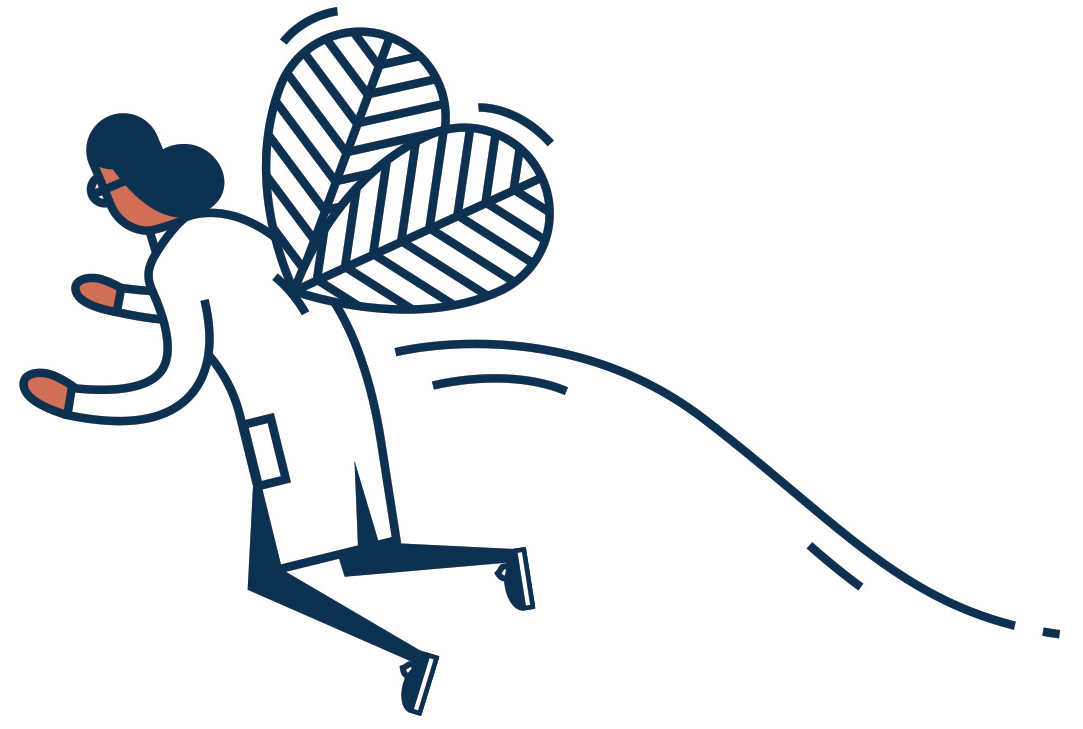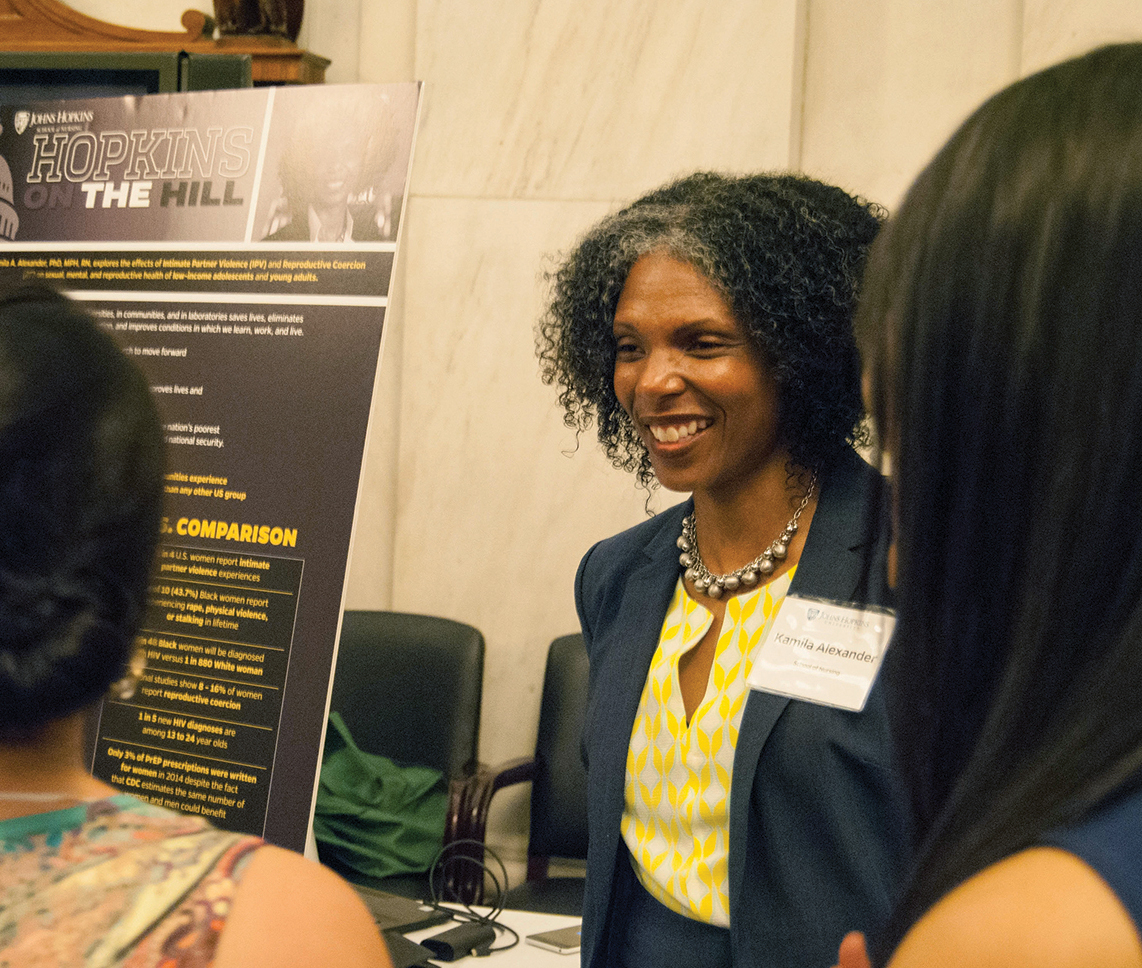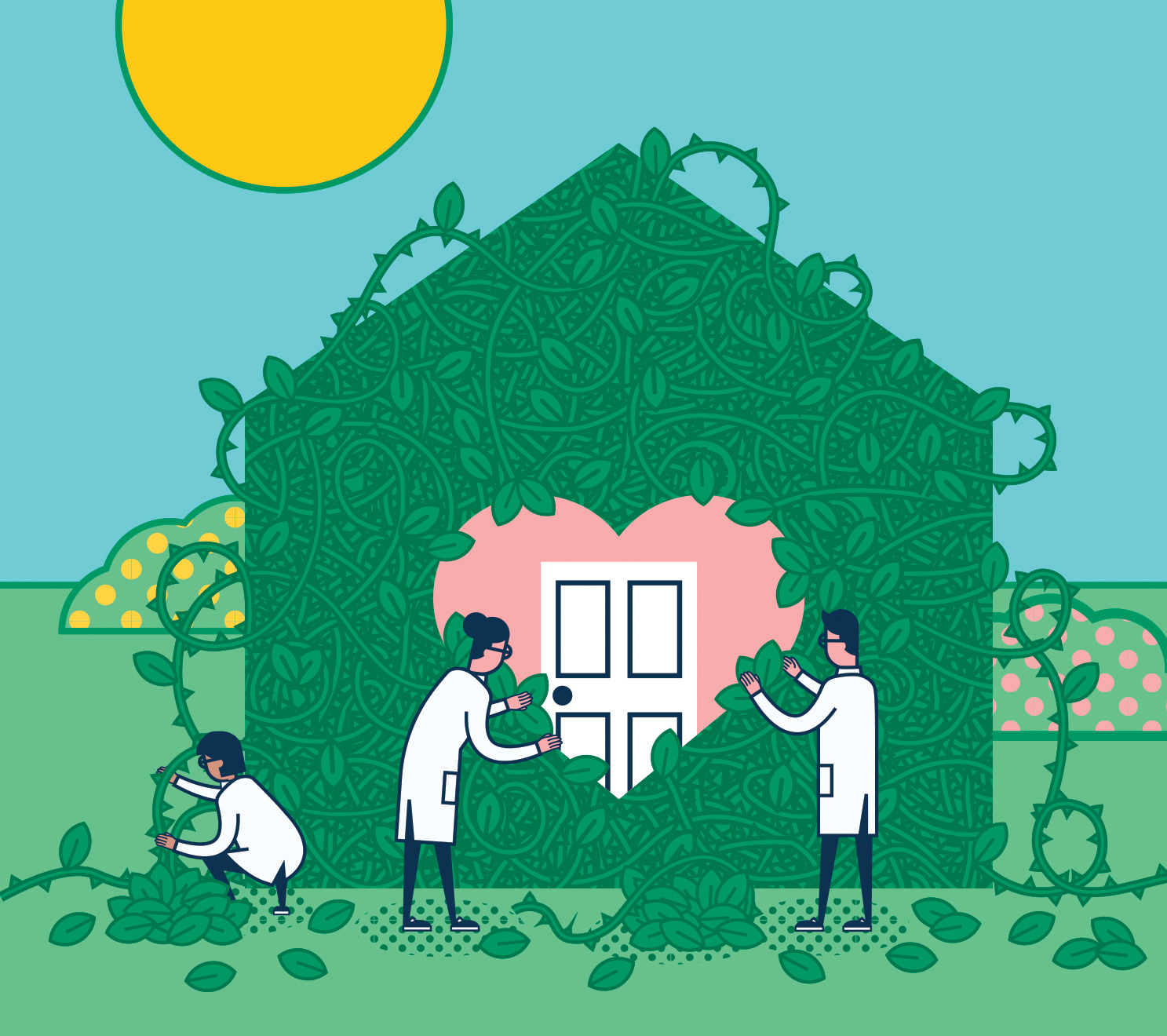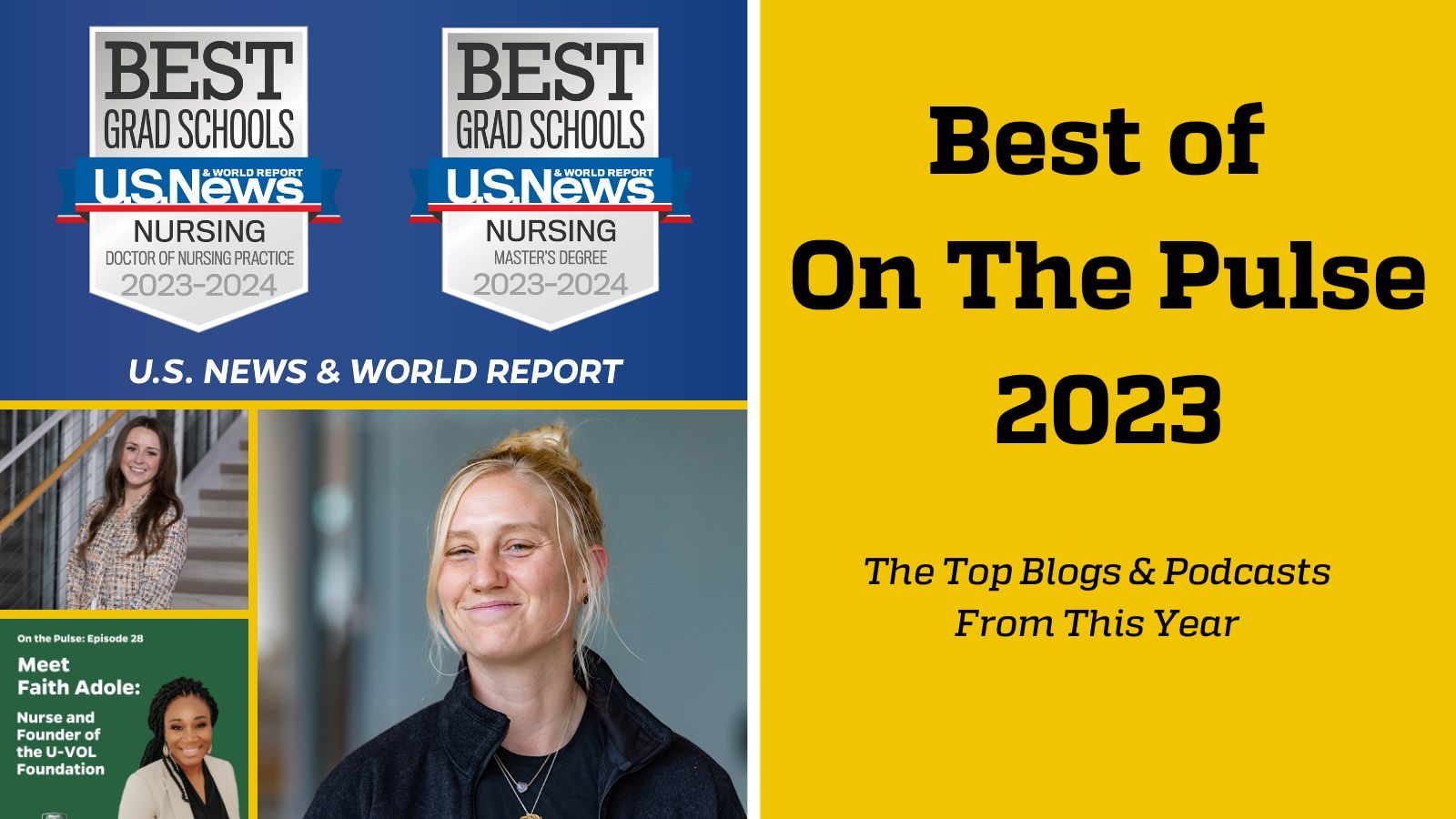Story By Brennen Jensen | Illustrations By Hylton Warburton
The health challenges that Johns Hopkins School of Nursing researchers confront can be across oceans or across town. They can be in a different hemisphere or the school’s own ZIP code. Baltimore’s areas of poverty and disinvestment present challenging and deeply rooted health inequities close at hand.
For instance, the Baltimore Health Department reports that African-American babies in Baltimore die at more than twice the rate of white babies. It’s a troubling statistic, and one that Assistant Professor Kelly Bower, PHD, MPH, RN, is too familiar with as a member of the city’s Fetal-Infant Mortality Review Team, a volunteer collection of health and social service professionals that reviews fetal and infant deaths within the city.

It is also the sort of multi-pronged issue that’s propelling School of Nursing (JHSON) faculty and researchers to more and more often seek a collaborative approach—reaching out for funding and help from across town in Homewood or across the street at the Johns Hopkins schools of Medicine and Public Health.
Bower recently received a $10,000 grant from the Johns Hopkins Urban Health Institute to create a community advisory board for B’More for Healthy Babies, a citywide initiative to improve health outcomes for mothers and for children under age 5. And the collaboration flows both ways.
“Working in partnership with the community to guide the initiative is a way to make sure that those who are receiving services are also helping to determine what services should be delivered and how they should be delivered,” Bower says. “We’ve recruited 17 community members and we’re meeting on a monthly basis, informing the work. We’re hoping to do a power analysis where the community members identify places where systemic racism shows up in maternal and child health through their experiences in Baltimore City.”
JHSON’s Office for Science and Innovation and Sponsored Projects team partner with faculty, staff, and students to both encourage and facilitate the expansion of collaborative research projects, a growing phenomenon across the university with a direct effect on maximizing research dollars in many strategic areas.
“I think the way funding is going, it is really requiring that we enter professional collaborations,” Bower says. “But I also think that interprofessional collaboration really results in better research. More minds, more perspectives—it increases your breadth and also your depth in understanding health issues and then being able to come up with really innovative and effective solutions to those issues.”
Nurses and nursing researchers bring plenty to the table in any collaboration. “We’re probably the only discipline that has approached patient care and research from a holistic perspective,” explains Phyllis Sharps, PhD, RN, FAAN, professor and associate dean for community programs and initiatives. “And so we certainly understand diseases and the pathophysiology and physiology but we also understand environmental context and how the interactions between people and their families and their communities influence health and health outcomes. So as research is being put together, I think this is what we introduce into other perspectives.”
Sharps, whose extensive and ongoing collaborative research addresses intimate partner violence, points out the School of Nursing’s deep roots in the community.

Hopkins Nursing on the Hill
Assistant Professor Kamila Alexander, PhD, MPH, RN, represented the Johns Hopkins School of Nursing (JHSON) at the inaugural Hopkins on the Hill event on June 13. Researchers and practitioners from across the university presented innovative work to Washington DC decision makers to show the impact of federally funded research.
Alexander’s work includes research into the risks of unplanned pregnancies and sexually transmitted infections in abusive dating and intimate relationships. It looks at consequences to mental, reproductive, and sexual health of poverty-related trauma and experiences of violence and explores the acceptability of pre-exposure prophylaxis (PrEP) as a potentially effective intervention to decrease HIV/AIDS risks. In Washington, she shared a video showing what nurses here at JHSON are doing to improve the health and well-being of people across the nation and world.
View the video at magazine.nursing.jhu.edu/onthehill
JHSON established an on-site health clinic at House of Ruth, one of Baltimore’s first crisis centers for victims of intimate partner violence, nearly 20 years ago. Numerous grants from the Urban Health Institute and others have expanded work there. More recently, such grants are introducing health programs at Henderson-Hopkins in East Baltimore, a K-8 school with the additional mission of whole-community health awareness.
“Nurses have always been at the table in terms of being the frontline workers with respect to delivering care in the community and addressing the needs of populations,” Bower adds. “But I think now, in terms of research, public health nurses are making big contributions.”
“I like to think of us as a little sister when we compare ourselves to [the schools of] Public Health and Medicine,” Sharps adds. “But for a small school with a small faculty, we rank pretty high in the amount of NIH research funding we attract, and a lot of it is the spirit of collaboration we offer to research teams.”
Following are three such collaborative projects.


Researcher:
Assistant Professor Kamila Alexander, PhD, MPH, RN
Collaborator/funder:
Johns Hopkins Population Center/Eunice Kennedy Shriver Institute of Child Health and Human Development
Women who experienced intimate partner violence are four times as likely to be infected with HIV as women in non-violent relationships.
Centers for Disease Control
An antiviral drug, taken daily, can reduce the risk of HIV infection by more than 90 percent. Referred to as pre-exposure prophylaxis, or PrEP, it can be an essential health intervention for individuals at high risk for HIV exposure. Its usage is promoted within the gay community, with a particular emphasis on a high-risk group: young black men who have sex with other young black men.
“There’s about the same number of young women at risk, but there’s little outreach to them,” explains Kamila Alexander. And she already knows they would be interested in PrEP, based on earlier surveys of young women in disadvantaged Baltimore neighborhoods, many of whom had experienced reproductive coercion or intimate partner violence.
“I got an overwhelming response,” Alexander says. “About 77 percent of the young women said they would be interested [in PrEP]. And within that group, there were about 35 percent of the young women who reported some sort of intimate partner violence—a lot higher than the national average, which is about 25 percent.”
Women in abusive relationships are at higher risk of HIV because they have less autonomy—they are less able to insist on condom use and are more likely to be forced or coerced into sex. It is also known that the majority of women in violent relationships have no immediate plans to leave. Alexander’s study, “Feasibility of a Multi-Sector Collaboration to Increase Contraceptive Use and Initiate PrEP Uptake among IPV-Exposed Women,” will start by interviewing reproductive health care providers and those who work to prevent intimate partner violence to determine how they might collaborate to bring PrEP to at-risk women. Then, she will survey women who experience intimate partner violence about their safety strategies.
“A majority have found ways to maintain their safety, and we want determine what those strategies are to see if taking a pill every day could actually be part of them,” Alexander says. “For instance, it might be that they could keep the pills at their workplace where their partner would not find them. We really don’t want to just make it more available and give them a prescription if they’re not going to be able to take it—if it’s not going to fit into their lives.”


Researcher:
Kelly Bower
Collaborator/funder:
Clinical Research Scholars Program, Johns Hopkins Medicine
Among developed nations, the United States ranks 41st in maternal mortality, 29th in infant mortality, and 30th in preterm births.
UNICEF
Maternal home visitation programs are a fairly straightforward intervention. Nurses or other health care workers make periodic visits to the homes of low-income pregnant women to discuss prenatal care, the warning signs of an early birth or pregnancy complications, breastfeeding, parenting, and how to access health and social services in the community. Programs vary, but many continue until a child turns 3. The Affordable Care Act allocated more than $1.5 billion to fund the expansion of such programs. The reason is simple: They’re proven to be beneficial.
“There is really strong evidence showing that home visiting not only improves birth outcomes, but also improves economic and household outcomes for moms and their children,” Bower says. “They reduce child abuse and neglect and improve mom’s financial stability moving forward.”
Still, the free service is too often declined. Bower acknowledges that it is a pretty intimate act—a woman or a family opening doors to an outsider. Her research is looking at the role traumatic experiences in a woman’s past may play in a decision whether to accept such home visits.
“My hypothesis is that if a mom experienced some sort of trauma growing up that it may impact her attachment style and her trust of relationships,” Bower says. “This may influence her willingness to engage in a supportive relationship where you let somebody come into the home and visit on a regular basis.”
Bower will survey women who have accepted visitations as well as those who have declined, asking why they made their choices and inquiring about adverse childhood experiences and trauma. If there appears to be a correlation, the next step will be to explore new and different ways of communicating with expectant mothers.
“We would start thinking about innovative ways of reaching out to women that would be more sensitive and trauma-informed,” Bower says.


Researcher:
Andrea Cimino, PhD, MSW
Collaborator/funder:
JHU Center for AIDS Research
Baltimore began the decade with a 68 percent increase in reported rapes.
Maryland Coalition Against Sexual Assault
JHSON Faculty Research Associate Andrea Cimino is interested in the dynamics of extended stress in low-income African-American women for an important reason: “Women experiencing cumulative violence have a blunted cortisol response, which may actually make them more susceptible to HIV,” she says. “So when your immune system isn’t working right, it can’t fight off infection.”
Adding urgency, Baltimore is one among the top 10 HIV-impacted areas in the country, and among women, African Americans have the most HIV-related deaths.
The body has a glandular response to stress that can be measured by examining the levels of certain hormones with pro- and anti-inflammatory properties, such as cortisol, known colloquially as the “stress hormone.” This spring, Cimino launched her study, “Understanding the Effect of Immunomodulatory Mediators on Systemic Inflammation Among African American Women at Risk for HIV and Exposed to Intimate Partner Violence.”
“We’ll be looking at how violence exposure is correlated with pro- and anti-inflammatory responses and we’ll control for built and social environmental effects to see if maybe one of those drives the physiological components over the others,” she explains.
The study is essentially a subset of the larger, ongoing Essence Project launched by Professor Jacquelyn Campbell, PhD, RN, FAAN, and former JHSON post-doctoral fellow Jamila Stockman, PhD, MPH (now an associate professor at the University of California, San Diego). In Baltimore, Essence assembled a cohort of 400 HIV-negative African-American women at increased risk for contracting the virus. All have been extensively surveyed about life experiences and whether they have suffered intimate partner violence. As part of the study, the women are taught to collect and submit multiple saliva samples to be analyzed for hormone levels.
“What I’m really interested in is this notion of resilience—when you are exposed to some sort of adversity and are overcoming it or are even becoming better and stronger,” Cimino says. “So what I am trying to do here is to look at physiological or biological mediators that could indicate that some women are more resilient to violence.”

 Forging Policy: How Can Doulas Improve Black Maternal Health?
Forging Policy: How Can Doulas Improve Black Maternal Health? You’re Welcome
You’re Welcome My First Teachers in Nursing School Weren’t Nurses
My First Teachers in Nursing School Weren’t Nurses Nursing Named Most Trusted Profession for 22nd Consecutive Year
Nursing Named Most Trusted Profession for 22nd Consecutive Year Best of On The Pulse 2023
Best of On The Pulse 2023






